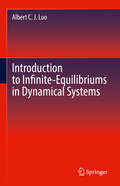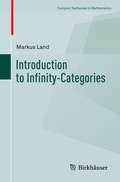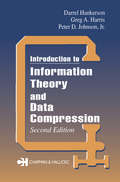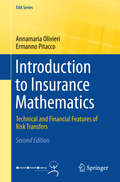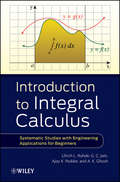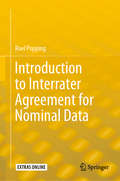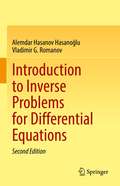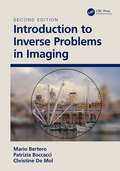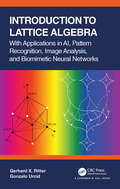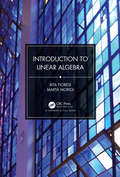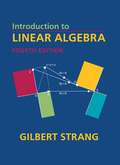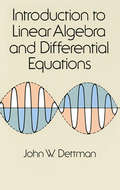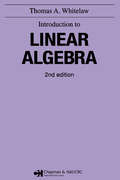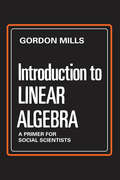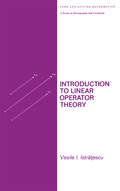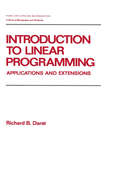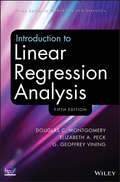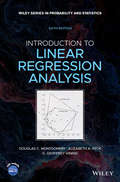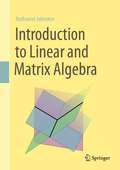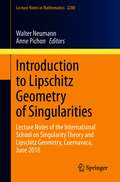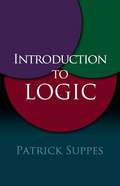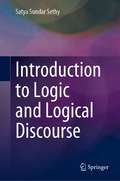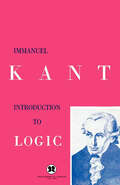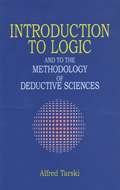- Table View
- List View
Introduction to Infinite-Equilibriums in Dynamical Systems
by Albert C.J LuoThis book examines infinite-equilibriums for the switching bifurcations of two 1-dimensional flows in dynamical systems. Quadratic single-linear-bivariate systems are adopted to discuss infinite-equilibriums in dynamical systems. For such quadratic dynamical systems, there are three types of infinite-equilibriums. The inflection-source and sink infinite-equilibriums are for the switching bifurcations of two parabola flows on the two-directions. The parabola-source and sink infinite-equilibriums are for the switching bifurcations of parabola and inflection flows on the two-directions. The inflection upper and lower-saddle infinite-equilibriums are for the switching bifurcation of two inflection flows in two directions. The inflection flows are for appearing bifurcations of two parabola flows on the same direction. Such switching bifurcations for 1-dimensional flow are based on the infinite-equilibriums, which will help one understand global dynamics in nonlinear dynamical systems. This book introduces infinite-equilibrium concepts and such switching bifurcations to nonlinear dynamics.
Introduction to Infinity-Categories (Compact Textbooks in Mathematics)
by Markus LandThis textbook is an introduction to the theory of infinity-categories, a tool used in many aspects of modern pure mathematics. It treats the basics of the theory and supplies all the necessary details while leading the reader along a streamlined path from the basic definitions to more advanced results such as the very important adjoint functor theorems. The book is based on lectures given by the author on the topic. While the material itself is well-known to experts, the presentation of the material is, in parts, novel and accessible to non-experts. Exercises complement this textbook that can be used both in a classroom setting at the graduate level and as an introductory text for the interested reader.
Introduction to Information Theory and Data Compression (Applied Mathematics)
by Peter D. Johnson Jr. Greg A. Harris D.C. HankersonAn effective blend of carefully explained theory and practical applications, this text imparts the fundamentals of both information theory and data compression. Although the two topics are related, this unique text allows either topic to be presented independently, and it was specifically designed so that the data compression section requires no pr
Introduction to Insurance Mathematics
by Ermanno Pitacco Annamaria OlivieriThis second edition expands the first chapters, which focus on the approach to risk management issues discussed in the first edition, to offer readers a better understanding of the risk management process and the relevant quantitative phases. In the following chapters the book examines life insurance, non-life insurance and pension plans, presenting the technical and financial aspects of risk transfers and insurance without the use of complex mathematical tools. The book is written in a comprehensible style making it easily accessible to advanced undergraduate and graduate students in Economics, Business and Finance, as well as undergraduate students in Mathematics who intend starting on an actuarial qualification path. With the systematic inclusion of practical topics, professionals will find this text useful when working in insurance and pension related areas, where investments, risk analysis and financial reporting play a major role.
Introduction to Integral Calculus
by Ulrich L. Rohde G. C. Jain Ajay K. Poddar A. K. GhoshAn accessible introduction to the fundamentals of calculus needed to solve current problems in engineering and the physical sciences I ntegration is an important function of calculus, and Introduction to Integral Calculus combines fundamental concepts with scientific problems to develop intuition and skills for solving mathematical problems related to engineering and the physical sciences. The authors provide a solid introduction to integral calculus and feature applications of integration, solutions of differential equations, and evaluation methods. With logical organization coupled with clear, simple explanations, the authors reinforce new concepts to progressively build skills and knowledge, and numerous real-world examples as well as intriguing applications help readers to better understand the connections between the theory of calculus and practical problem solving. The first six chapters address the prerequisites needed to understand the principles of integral calculus and explore such topics as anti-derivatives, methods of converting integrals into standard form, and the concept of area. Next, the authors review numerous methods and applications of integral calculus, including: Mastering and applying the first and second fundamental theorems of calculus to compute definite integrals Defining the natural logarithmic function using calculus Evaluating definite integrals Calculating plane areas bounded by curves Applying basic concepts of differential equations to solve ordinary differential equations With this book as their guide, readers quickly learn to solve a broad range of current problems throughout the physical sciences and engineering that can only be solved with calculus. Examples throughout provide practical guidance, and practice problems and exercises allow for further development and fine-tuning of various calculus skills. Introduction to Integral Calculus is an excellent book for upper-undergraduate calculus courses and is also an ideal reference for students and professionals who would like to gain a further understanding of the use of calculus to solve problems in a simplified manner.
Introduction to Interrater Agreement for Nominal Data (SpringerBriefs in Statistics)
by Roel PoppingThis introductory book enables researchers and students of all backgrounds to compute interrater agreements for nominal data. It presents an overview of available indices, requirements, and steps to be taken in a research project with regard to reliability, preceded by agreement. The book explains the importance of computing the interrater agreement and how to calculate the corresponding indices. Furthermore, it discusses current views on chance expected agreement and problems related to different research situations, so as to help the reader consider what must be taken into account in order to achieve a proper use of the indices.The book offers a practical guide for researchers, Ph.D. and master students, including those without any previous training in statistics (such as in sociology, psychology or medicine), as well as policymakers who have to make decisions based on research outcomes in which these types of indices are used.
Introduction to Inverse Problems for Differential Equations
by Vladimir G. Romanov Alemdar Hasanov HasanoğluThis book presents a systematic exposition of the main ideas and methods in treating inverse problems for PDEs arising in basic mathematical models, though it makes no claim to being exhaustive. Mathematical models of most physical phenomena are governed by initial and boundary value problems for PDEs, and inverse problems governed by these equations arise naturally in nearly all branches of science and engineering.The book’s content, especially in the Introduction and Part I, is self-contained and is intended to also be accessible for beginning graduate students, whose mathematical background includes only basic courses in advanced calculus, PDEs and functional analysis. Further, the book can be used as the backbone for a lecture course on inverse and ill-posed problems for partial differential equations.In turn, the second part of the book consists of six nearly-independent chapters. The choice of these chapters was motivated by the fact that the inverse coefficient and source problems considered here are based on the basic and commonly used mathematical models governed by PDEs. These chapters describe not only these inverse problems, but also main inversion methods and techniques. Since the most distinctive features of any inverse problems related to PDEs are hidden in the properties of the corresponding solutions to direct problems, special attention is paid to the investigation of these properties.For the second edition, the authors have added two new chapters focusing on real-world applications of inverse problems arising in wave and vibration phenomena. They have also revised the whole text of the first edition.
Introduction to Inverse Problems in Imaging
by M. Bertero P. Boccacci Christine De MolFully updated throughout, with several new chapters, this second edition of Introduction to Inverse Problems in Imaging guides advanced undergraduate and graduate students in physics, computer science, mathematics and engineering through the principles of linear inverse problems, in addition to methods of their approximate solution and their practical applications in imaging. The level of mathematical treatment is kept as low as possible to make the book suitable for a wide range of readers from different backgrounds, with readers needing just a rudimentary understanding of analysis, geometry, linear algebra, probability theory, and Fourier analysis. This second edition contains new chapters on quadratic, iterative, and sparsity-enforcing tikhonov regularizations in addition to maximum likelihood methods and bayesian regularization. The authors concentrate on presenting easily implementable and fast solution algorithms. With examples and exercised throughout, the book will provide the reader with the appropriate background for a clear understanding of the essence of inverse problems (ill-posedness and its cure) and, consequently, for an intelligent assessment of the rapidly growing literature on these problems. Key features: · Provides an accessible introduction to the topic, whilst keeping mathematics to a minimum · Interdisciplinary topic with growing relevance and wide-ranging applications · Accompanied by numerical examples throughout Author bios Mario Bertero is a Professor Emeritus at the Università di Genova. Patrizia Boccacci is a Professor at the Università di Genova. Christine De Mol is a Professor at the Université libre de Bruxelles.
Introduction to Lattice Algebra: With Applications in AI, Pattern Recognition, Image Analysis, and Biomimetic Neural Networks
by Gerhard X. Ritter Gonzalo UrcidLattice theory extends into virtually every branch of mathematics, ranging from measure theory and convex geometry to probability theory and topology. A more recent development has been the rapid escalation of employing lattice theory for various applications outside the domain of pure mathematics. These applications range from electronic communication theory and gate array devices that implement Boolean logic to artificial intelligence and computer science in general. Introduction to Lattice Algebra: With Applications in AI, Pattern Recognition, Image Analysis, and Biomimetic Neural Networks lays emphasis on two subjects, the first being lattice algebra and the second the practical applications of that algebra. This textbook is intended to be used for a special topics course in artificial intelligence with a focus on pattern recognition, multispectral image analysis, and biomimetic artificial neural networks. The book is self-contained and – depending on the student’s major – can be used for a senior undergraduate level or first-year graduate level course. The book is also an ideal self-study guide for researchers and professionals in the above-mentioned disciplines. Features Filled with instructive examples and exercises to help build understanding Suitable for researchers, professionals and students, both in mathematics and computer science Every chapter consists of exercises with solution provided online at www.Routledge.com/9780367720292
Introduction to Linear Algebra
by Rita Fioresi Marta MorigiLinear algebra provides the essential mathematical tools to tackle all the problems in Science. Introduction to Linear Algebra is primarily aimed at students in applied fields (e.g. Computer Science and Engineering), providing them with a concrete, rigorous approach to face and solve various types of problems for the applications of their interest. This book offers a straightforward introduction to linear algebra that requires a minimal mathematical background to read and engage with. Features Presented in a brief, informative and engaging style Suitable for a wide broad range of undergraduates Contains many worked examples and exercises
Introduction to Linear Algebra (4th Edition)
by Gilbert StrangThis leading textbook for first courses in linear algebra comes from the hugely experienced MIT lecturer and author Gilbert Strang. The book's tried and tested approach is direct, offering practical explanations and examples, while showing the beauty and variety of the subject. Unlike most other linear algebra textbooks, the approach is not a repetitive drill. Instead it inspires an understanding of real mathematics. The book moves gradually and naturally from numbers to vectors to the four fundamental subspaces. This new edition includes challenge problems at the end of each section.
Introduction to Linear Algebra and Differential Equations
by John W. DettmanExcellent introductory text focuses on complex numbers, determinants, orthonormal bases, symmetric and hermitian matrices, first order non-linear equations, linear differential equations, Laplace transforms, Bessel functions, more. Includes 48 black-and-white illustrations. Exercises with solutions. Index.
Introduction to Linear Algebra, 2nd edition
by Thomas A WhitelawThis popular textbook was thoughtfully and specifically tailored to introducing undergraduate students to linear algebra. The second edition has been carefully revised to improve upon its already successful format and approach. In particular, the author added a chapter on quadratic forms, making this one of the most comprehensive introductory te
Introduction to Linear Algebra: A Primer for Social Scientists
by Gordon MillsThis is the first book on linear algebra written specifically for social scientists. It deals only with those aspects of the subject applicable in the social sciences and provides a thorough understanding of linear algebra for those who wish to use it as a tool in the design, execution, and interpretation of research. Linear mathematical models play an important role in all of the social sciences. This book provides a step-by-step introduction to those parts of linear algebra which are useful in such model building. It illustrates some of the applications of linear analysis and helps the reader learn how to convert his formulation of a social science problem into algebraic terms. The author covers matrix algebra, computational methods, linear models involving discrete variables, and clear, complete explanations of necessary mathematical concepts. Prior knowledge of calculus is not required since no use is made of calculus or of complex numbers. A novel feature of the mathematical content of the book is the treatment of models expressed in terms of variables which must be whole numbers (integers). The book is distinguished by a step-by-step exposition that allows the reader to grasp quickly and fully the principles of linear algebra. All of the examples used to illustrate the text are drawn from the social sciences, enabling the reader to relate the subject to concrete problems in his field. Exercises are included as a necessary part of the text to develop points not covered in the text and to provide practice in the algebraic formulation of applied problems. An appendix gives solutions (or hints) for selected exercises.
Introduction to Linear Operator Theory
by Vasile I. IstratescuThis book is an introduction to the subject and is devoted to standard material on linear functional analysis, and presents some ergodic theorems for classes of operators containing the quasi-compact operators. It discusses various classes of operators connected with the numerical range.
Introduction to Linear Programming: Applications and Extensions
by Richard B. DarstStressing the use of several software packages based on simplex method variations, this text teaches linear programming's four phases through actual practice. It shows how to decide whether LP models should be applied, set up appropriate models, use software to solve them, and examine solutions to a
Introduction to Linear Regression Analysis
by Douglas C. Montgomery Elizabeth A. Peck G. Geoffrey ViningAs the Solutions Manual, this book is meant to accompany the main title, Introduction to Linear Regression Analysis, Fifth Edition. Clearly balancing theory with applications, this book describes both the conventional and less common uses of linear regression in the practical context of today's mathematical and scientific research. Beginning with a general introduction to regression modeling, including typical applications, the book then outlines a host of technical tools that form the linear regression analytical arsenal, including: basic inference procedures and introductory aspects of model adequacy checking; how transformations and weighted least squares can be used to resolve problems of model inadequacy; how to deal with influential observations; and polynomial regression models and their variations. The book also includes material on regression models with autocorrelated errors, bootstrapping regression estimates, classification and regression trees, and regression model validation.
Introduction to Linear Regression Analysis (Wiley Series in Probability and Statistics #821)
by Douglas C. Montgomery Elizabeth A. Peck G. Geoffrey ViningA comprehensive and current introduction to the fundamentals of regression analysis Introduction to Linear Regression Analysis, 6th Edition is the most comprehensive, fulsome, and current examination of the foundations of linear regression analysis. Fully updated in this new sixth edition, the distinguished authors have included new material on generalized regression techniques and new examples to help the reader understand retain the concepts taught in the book. The new edition focuses on four key areas of improvement over the fifth edition: New exercises and data sets New material on generalized regression techniques The inclusion of JMP software in key areas Carefully condensing the text where possible Introduction to Linear Regression Analysis skillfully blends theory and application in both the conventional and less common uses of regression analysis in today's cutting-edge scientific research. The text equips readers to understand the basic principles needed to apply regression model-building techniques in various fields of study, including engineering, management, and the health sciences.
Introduction to Linear and Matrix Algebra
by Nathaniel JohnstonThis textbook emphasizes the interplay between algebra and geometry to motivate the study of linear algebra. Matrices and linear transformations are presented as two sides of the same coin, with their connection motivating inquiry throughout the book. By focusing on this interface, the author offers a conceptual appreciation of the mathematics that is at the heart of further theory and applications. Those continuing to a second course in linear algebra will appreciate the companion volume Advanced Linear and Matrix Algebra. Starting with an introduction to vectors, matrices, and linear transformations, the book focuses on building a geometric intuition of what these tools represent. Linear systems offer a powerful application of the ideas seen so far, and lead onto the introduction of subspaces, linear independence, bases, and rank. Investigation then focuses on the algebraic properties of matrices that illuminate the geometry of the linear transformations that they represent. Determinants, eigenvalues, and eigenvectors all benefit from this geometric viewpoint. Throughout, “Extra Topic” sections augment the core content with a wide range of ideas and applications, from linear programming, to power iteration and linear recurrence relations. Exercises of all levels accompany each section, including many designed to be tackled using computer software. Introduction to Linear and Matrix Algebra is ideal for an introductory proof-based linear algebra course. The engaging color presentation and frequent marginal notes showcase the author’s visual approach. Students are assumed to have completed one or two university-level mathematics courses, though calculus is not an explicit requirement. Instructors will appreciate the ample opportunities to choose topics that align with the needs of each classroom, and the online homework sets that are available through WeBWorK.
Introduction to Lipschitz Geometry of Singularities: Lecture Notes of the International School on Singularity Theory and Lipschitz Geometry, Cuernavaca, June 2018 (Lecture Notes in Mathematics #2280)
by Walter Neumann Anne PichonThis book presents a broad overview of the important recent progress which led to the emergence of new ideas in Lipschitz geometry and singularities, and started to build bridges to several major areas of singularity theory. Providing all the necessary background in a series of introductory lectures, it also contains Pham and Teissier's previously unpublished pioneering work on the Lipschitz classification of germs of plane complex algebraic curves. While a real or complex algebraic variety is topologically locally conical, it is in general not metrically conical; there are parts of its link with non-trivial topology which shrink faster than linearly when approaching the special point. The essence of the Lipschitz geometry of singularities is captured by the problem of building classifications of the germs up to local bi-Lipschitz homeomorphism. The Lipschitz geometry of a singular space germ is then its equivalence class in this category. The book is aimed at graduate students and researchers from other fields of geometry who are interested in studying the multiple open questions offered by this new subject.
Introduction to Logic
by Immanuel Kant T K AbbottWritten during the height of the Enlightenment, Immanuel Kant's Introduction to Logic is an essential primer for anyone interested in the study of Kantian views on logic, aesthetics, and moral reasoning. More accessible than his other books, Introduction to Logic lays the foundation for his writings with a clear discussion of each of his philosophical pursuits. For more advanced Kantian scholars, this book can bring to light some of the enduring issues in Kant's repertoire; for the beginner, it can open up the philosophical ideas of one of the most influential thinkers on modern philosophy. This edition comprises two parts: "Introduction to Logic" and an essay titled "The False Subtlety of the Four Syllogistic Figures," in which Kant analyzes Aristotelian logic.
Introduction to Logic
by Patrick SuppesPart I of this coherent, well-organized text deals with formal principles of inference and definition. Part II explores elementary intuitive set theory, with separate chapters on sets, relations, and functions. Ideal for undergraduates.
Introduction to Logic and Logical Discourse
by Satya Sundar SethyThis book focuses on logic and logical language. It examines different types of words, terms and propositions in detail. While discussing the nature of propositions, it illustrates the procedures used to determine the truth and falsity of a proposition, and the validity and invalidity of an argument. In addition, the book provides a clear exposition of the pure and mixed form of syllogism with suitable examples. The book encompasses sentential logic, predicate logic, symbolic logic, induction and set theory topics. The book is designed to serve all those involved in teaching and learning courses on logic. It offers a valuable resource for students and researchers in philosophy, mathematics and computer science disciplines. Given its scope, it is an essential read for everyone interested in logic, language, formulation of the hypotheses for the scientific enquiries and research studies, and judging valid and invalid arguments in the natural language discourse.
Introduction to Logic: And His Essay On The Mistaken Subtilty Of The Four Figures
by Immanuel KantThis essential text by one of the founders of modern philosophy offers an accessible introduction to his views on logic, aesthetics, and morality. Written during the height of the Enlightenment, Immanuel Kant&’s Introduction to Logic is a clear and concise primer for his larger works Critique of Pure Reason and Groundwork for the Metaphysics of Morals. More accessible than his other books, it provides definitions of Kantian terms and a clear discussion of each of his philosophical pursuits. For more advanced Kantian scholars, this book can bring to light some of the enduring issues in Kant&’s repertoire; for the beginner, it can open up the philosophical ideas of one of the most influential thinkers on modern philosophy. This edition comprises two parts: &“Kant&’s Introduction to Logic&” and an essay titled &“The Mistaken Subtilty of the Four Syllogistic Figures,&” in which Kant analyzes Aristotelian logic.
Introduction to Logic: and to the Methodology of Deductive Sciences (Oxford Logic Guides #24)
by Alfred TarskiFirst published in Polish in 1936, this classic work was originally written as a popular scientific book — one that would present to the educated lay reader a clear picture of certain powerful trends of thought in modern logic. According to the author, these trends sought to create a unified conceptual apparatus as a common basis for the whole of human knowledge.Because these new developments in logical thought tended to perfect and sharpen the deductive method, an indispensable tool in many fields for deriving conclusions from accepted assumptions, the author decided to widen the scope of the work. In subsequent editions he revised the book to make it also a text on which to base an elementary college course in logic and the methodology of deductive sciences. It is this revised edition that is reprinted here.Part One deals with elements of logic and the deductive method, including the use of variables, sentential calculus, theory of identity, theory of classes, theory of relations and the deductive method. The Second Part covers applications of logic and methodology in constructing mathematical theories, including laws of order for numbers, laws of addition and subtraction, methodological considerations on the constructed theory, foundations of arithmetic of real numbers, and more. The author has provided numerous exercises to help students assimilate the material, which not only provides a stimulating and thought-provoking introduction to the fundamentals of logical thought, but is the perfect adjunct to courses in logic and the foundation of mathematics.
